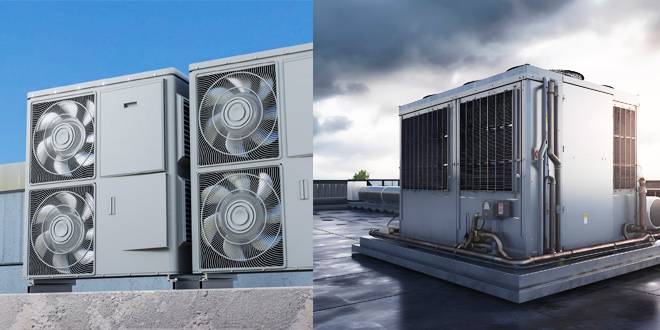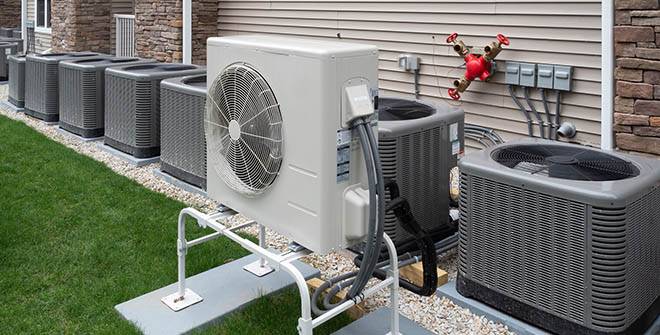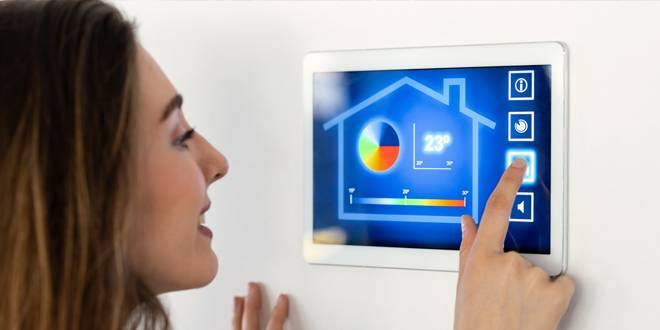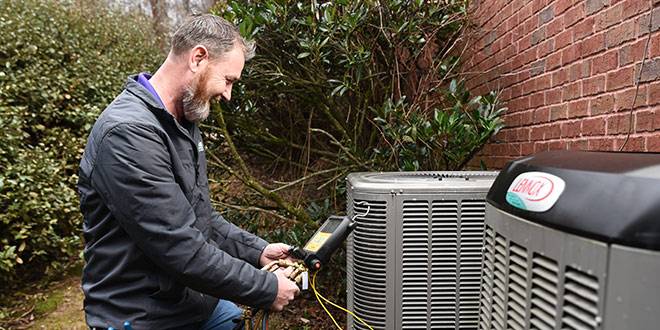
Choosing the right HVAC system is crucial for maintaining comfort in your home or business while ensuring energy efficiency and cost-effectiveness. With various options available, it can be challenging to determine which system best suits your needs. Two popular choices are split systems and packaged units. Each offers unique benefits and considerations that can impact your decision.
In this blog, we will explore the key differences between split systems and packaged units, helping you make an informed choice. By understanding how each system works, their pros and cons, and their cost and efficiency, you can find the perfect HVAC solution tailored to your specific requirements. For more information about our services, including air conditioning installation, repair, and maintenance in Suwanee, visit our Air Conditioning Services page.
What is a Split System?
A split system is a type of HVAC system that consists of two main components: an outdoor unit and an indoor unit. The outdoor unit typically houses the condenser and compressor, while the indoor unit contains the evaporator coil and air handler. These two units work together to cool or heat your home effectively.
How It Works:
- The outdoor unit compresses and circulates refrigerant through the system.
- The refrigerant absorbs heat from the indoor air at the evaporator coil, cooling the air in the process.
- The cooled air is then circulated throughout the home via the air handler and ductwork.
- The refrigerant returns to the outdoor unit, where it releases the absorbed heat and the cycle repeats.
Common Applications:
- Residential homes
- Small commercial buildings
- Multi-family residences
Split systems are popular because they offer flexibility in installation, allowing for the indoor unit to be placed in a convenient location inside the building while the outdoor unit remains outside. This separation can result in quieter indoor operation and more efficient cooling and heating.
For more details on our split system installations and services, check out our AC Installation Services.

What is a Packaged Unit?
A packaged unit is an all-in-one HVAC system that combines the heating and cooling components into a single outdoor unit. This unit is usually installed on the ground or on the roof of a building, making it a space-saving option for many properties.
How It Works:
- The packaged unit houses all essential components, including the compressor, condenser, evaporator coil, and air handler.
- Air is drawn into the unit, where it is cooled or heated.
- The conditioned air is then distributed throughout the building via ductwork.
- The system cycles the refrigerant to absorb and release heat, maintaining the desired indoor temperature.
Common Applications:
- Small to medium-sized commercial buildings
- Homes with limited indoor space for separate units
- Buildings with rooftop HVAC installations
Packaged units are appreciated for their compact design and ease of installation. Since all components are housed in a single unit, maintenance and repairs can be more straightforward, potentially reducing service time and costs.
For more information on maintaining and repairing packaged units, explore our AC Repair Services and AC Maintenance Services.

Key Differences Between Split Systems and Packaged Units
Understanding the key differences between split systems and packaged units can help you decide which HVAC solution is best for your needs. Here are some of the main distinctions:
1. Installation Process:
- Split Systems: Installation involves placing the indoor unit inside the building and the outdoor unit outside. This setup can be more flexible but may require more complex installation, especially if ductwork needs to be modified or extended.
- Packaged Units: These units are typically installed outside, either on the ground or on the roof. The all-in-one design simplifies the installation process since all components are housed in a single unit.
2. Space Requirements:
- Split Systems: Require indoor space for the air handler and evaporator coil, in addition to the outdoor unit. This can be a consideration if indoor space is limited.
- Packaged Units: Save indoor space as all components are located outside. This can be ideal for buildings with limited indoor mechanical space.
3. Maintenance Needs:
- Split Systems: Maintenance might involve servicing both the indoor and outdoor units separately. This can sometimes lead to more involved maintenance routines.
- Packaged Units: With all components in one location, maintenance can be more straightforward and potentially quicker, as technicians can access everything in a single visit.
4. Noise Levels:
- Split Systems: Often quieter indoors since the noisy components (compressor and condenser) are located outside.
- Packaged Units: Noise levels can be higher, especially if the unit is installed close to occupied areas, as all components are housed together.
5. Energy Efficiency:
- Split Systems: Tend to have higher energy efficiency ratings (SEER) due to the ability to optimize each component individually.
- Packaged Units: While they can also be efficient, they might not reach the same SEER ratings as split systems due to their integrated design.
Understanding these differences can help you choose the system that aligns best with your space, comfort, and maintenance preferences.
For expert advice and professional installation of either system, feel free to contact us through our Contact Us page.
Pros and Cons of Split Systems
When considering a split system for your HVAC needs, it’s important to weigh the advantages and disadvantages. Here’s a comprehensive look at the pros and cons:
Pros:
- Energy Efficiency: Split systems often have higher SEER ratings, which can result in lower energy bills and a smaller carbon footprint.
- Quiet Operation: Since the noisy components (compressor and condenser) are located outside, indoor noise levels are significantly reduced, enhancing indoor comfort.
- Flexible Installation: The separate components offer greater flexibility in installation, allowing for placement in various locations to suit your home’s design and layout.
- Zoning Capabilities: Split systems can be designed to include zoning, allowing for different areas of the home to be cooled or heated independently, enhancing overall comfort and efficiency.
- Better Indoor Air Quality: These systems can be equipped with advanced filtration options, improving indoor air quality by reducing pollutants and allergens.
Cons:
- Higher Initial Cost: Split systems can have a higher upfront cost compared to packaged units due to the separate components and potentially more complex installation.
- Space Requirements: The need for both indoor and outdoor units can be a drawback if indoor space is limited or if finding a suitable location for the outdoor unit is challenging.
- Maintenance Complexity: Maintaining both the indoor and outdoor units can be more involved, potentially leading to higher maintenance costs and the need for more frequent servicing.
- Aesthetic Impact: The presence of an outdoor unit can affect the exterior appearance of your property, which might be a consideration for some homeowners.
Considering these pros and cons can help you decide if a split system is the right choice for your home or business. For more details on installation and maintenance, visit our AC Installation Services and AC Maintenance Services pages.

Pros and Cons of Packaged Units
Packaged units offer a distinct set of advantages and disadvantages compared to split systems. Here’s a detailed look at the pros and cons:
Pros:
- Space-Saving Design: Since all components are housed in a single unit, packaged systems save valuable indoor space, making them ideal for homes and businesses with limited indoor room.
- Simpler Installation: The all-in-one design simplifies the installation process, often leading to lower installation costs and faster setup times.
- Easy Maintenance: With all components in one location, maintenance and repairs are more straightforward, which can reduce service time and costs.
- Aesthetic Appeal: Packaged units can be installed on rooftops or other out-of-the-way locations, minimizing their visual impact on the property’s exterior.
- Cost-Effective: Generally, packaged units can have a lower initial cost compared to split systems, making them a budget-friendly option.
Cons:
- Lower Energy Efficiency: Packaged units typically have lower SEER ratings compared to split systems, which can result in higher energy bills over time.
- Noise Levels: All components being in one unit can lead to higher noise levels, particularly if the unit is installed close to occupied areas.
- Limited Flexibility: The all-in-one design means less flexibility in placement, as the entire unit must be positioned outside, often on the ground or roof.
- Potential for Higher Wear and Tear: Because all components are exposed to the elements, packaged units may experience more wear and tear, potentially leading to more frequent repairs.
- Restricted Zoning Capabilities: Packaged units generally do not offer the same zoning capabilities as split systems, limiting the ability to control temperatures in different areas independently.
By considering these pros and cons, you can better determine if a packaged unit meets your specific needs and preferences. For assistance with choosing and installing a packaged unit, explore our AC Repair Services and Contact Us for expert advice.

Cost Comparison
When choosing between a split system and a packaged unit, cost is a significant factor. Here’s a breakdown of the various cost considerations for each system:
1. Initial Costs:
- Split Systems: Generally have higher upfront costs due to the need for separate indoor and outdoor units and potentially more complex installation requirements. However, the cost can vary depending on the brand, model, and additional features.
- Packaged Units: Typically, these units have lower initial costs as they combine all components into one single unit. Installation is usually simpler and faster, contributing to lower installation costs.
2. Long-Term Operating Costs:
- Split Systems: Often, split systems have higher energy efficiency (SEER ratings), which can result in lower monthly energy bills. Over time, the energy savings can offset the higher initial investment.
- Packaged Units: While generally less expensive to install, packaged units might have higher monthly operating costs due to lower energy efficiency. This can lead to higher energy bills over the system’s lifespan.
3. Maintenance Costs:
- Split Systems: Maintenance may be more involved, as both the indoor and outdoor units require servicing. This can lead to higher maintenance costs over time. However, the flexibility in component placement can make it easier to access and service certain parts.
- Packaged Units: With all components in a single location, maintenance and repairs can be more straightforward and less time-consuming, potentially resulting in lower service costs. However, being exposed to the elements can lead to more frequent repairs and maintenance needs.
4. Lifespan and Replacement Costs:
- Split Systems: Typically have a longer lifespan due to better protection from the elements and the ability to replace individual components as needed. However, when replacement is necessary, it may involve higher costs for separate units.
- Packaged Units: The lifespan may be shorter due to all components being exposed to weather conditions. When replacement is needed, the cost can be lower since it’s a single unit, but it will need to be replaced entirely rather than in parts.
When considering costs, it’s essential to think not only about the initial investment but also the long-term expenses associated with energy use, maintenance, and potential replacements. For financing options to help manage these costs, visit our Financing Solutions.
Energy Efficiency
Energy efficiency is a critical consideration when choosing between a split system and a packaged unit. Here’s how each system measures up in terms of efficiency and its impact on your energy bills:
1. Efficiency Ratings:
- Split Systems: Generally, split systems have higher Seasonal Energy Efficiency Ratio (SEER) ratings. This means they can cool or heat your space using less energy, leading to lower utility bills. Advanced features like variable-speed fans and multi-stage compressors can further enhance efficiency.
- Packaged Units: While some packaged units offer decent SEER ratings, they typically don’t reach the same efficiency levels as split systems. The all-in-one design can limit the system’s ability to optimize each component’s performance individually.
2. Impact on Energy Bills:
- Split Systems: Higher efficiency ratings translate to lower monthly energy costs. Over time, the savings on utility bills can offset the higher initial investment in a split system.
- Packaged Units: Although they may have lower upfront costs, the relatively lower efficiency means higher ongoing energy bills. This can add up significantly over the system’s lifespan.
3. Technological Features:
- Split Systems: Often come with advanced technological features such as smart thermostats, zoning capabilities, and energy-saving modes. These features help fine-tune the system’s operation, enhancing comfort and reducing energy consumption.
- Packaged Units: While they may include some energy-saving features, they generally offer fewer advanced options compared to split systems. However, modern packaged units are still designed to be more efficient than older models.
4. Environmental Impact:
- Split Systems: Their higher efficiency results in reduced energy consumption, which is beneficial for the environment. Lower energy use means fewer greenhouse gas emissions from power plants.
- Packaged Units: With slightly lower efficiency, packaged units may have a higher environmental impact due to increased energy consumption over time.
When evaluating energy efficiency, it’s important to consider not just the SEER rating but also the overall design and features of the system. Investing in a more efficient system can lead to substantial savings and a reduced environmental footprint.
For expert guidance on choosing an energy-efficient HVAC system, check out our AC Installation Services and Contact Us for personalized recommendations.

Which System is Right for You?
Choosing between a split system and a packaged unit depends on several factors, including your specific needs, preferences, and the characteristics of your home or business. Here are some key considerations to help you make an informed decision:
1. Home Size and Layout:
- Split Systems: Ideal for larger homes or buildings with multiple rooms. The flexibility in installation allows for zoning, making it easier to control the temperature in different areas independently.
- Packaged Units: Better suited for smaller homes or businesses with limited indoor space. The all-in-one design is space-saving and simplifies installation.
2. Climate:
- Split Systems: Often perform better in extreme climates, providing more efficient heating and cooling. They can be tailored to handle higher cooling loads in hot climates and better heating in colder regions.
- Packaged Units: Suitable for moderate climates where extreme heating or cooling is not frequently required. They can still provide adequate comfort but may not be as efficient in extreme conditions.
3. Budget:
- Split Systems: Higher initial costs but potential long-term savings due to better energy efficiency and lower operating costs. Ideal for those willing to invest upfront for future savings.
- Packaged Units: Lower upfront costs and simpler installation can be appealing for those on a tighter budget. However, consider the potential for higher energy bills over time.
4. Space Availability:
- Split Systems: Require indoor space for the air handler and evaporator coil. Suitable for homes with available mechanical space or where noise reduction is a priority.
- Packaged Units: Perfect for homes or businesses with limited indoor space. The unit is installed outside, saving valuable indoor real estate.
5. Maintenance Preferences:
- Split Systems: May require more frequent and involved maintenance, with the need to service both indoor and outdoor units. However, the flexibility in component placement can make access easier.
- Packaged Units: Easier maintenance due to all components being in one location. This can lead to quicker and potentially less costly service visits.
6. Long-Term Plans:
- Split Systems: A good choice if you plan to stay in your home or business for many years, as the initial investment can pay off with long-term energy savings.
- Packaged Units: A practical option for shorter-term plans or if immediate cost savings are a priority.
Ultimately, the best system for you will depend on balancing these factors according to your specific situation and priorities. For personalized advice and to explore which system is right for your needs, contact us through our Contact Us page.

Conclusion
Deciding between a split system and a packaged unit for your HVAC needs involves considering various factors, including your home’s size and layout, climate, budget, and maintenance preferences. Both systems offer unique benefits and potential drawbacks, making it essential to weigh these carefully to make the best choice for your situation.
Split systems are ideal for those seeking high energy efficiency, quieter operation, and greater flexibility in installation and zoning capabilities. While they may come with higher upfront costs and more complex maintenance, the long-term savings and enhanced comfort can make them a worthwhile investment.
Packaged units offer a compact, space-saving solution with simpler installation and maintenance. They are particularly suitable for smaller homes or businesses with limited indoor space and can provide adequate comfort at a lower initial cost. However, they may have higher ongoing energy expenses and a shorter lifespan due to exposure to the elements.
Ultimately, the right choice depends on your specific needs and circumstances. Consulting with HVAC professionals can provide valuable insights and help you make an informed decision. At Zen Air Heating & Cooling, we’re here to assist you in finding the perfect HVAC solution tailored to your needs. For expert advice and professional services, visit our Contact Us page or explore our Air Conditioning Services.
Remember, choosing the right HVAC system is not just about comfort—it’s about investing in the long-term well-being and efficiency of your home or business. Whatever system you choose, ensure it’s installed and maintained by experienced professionals to maximize its performance and lifespan.



